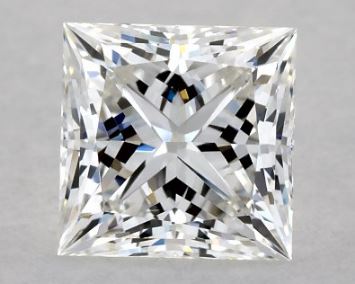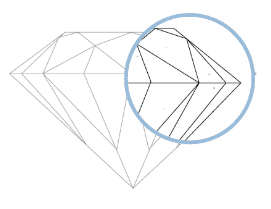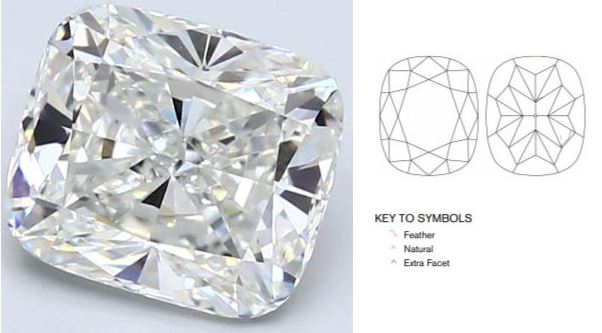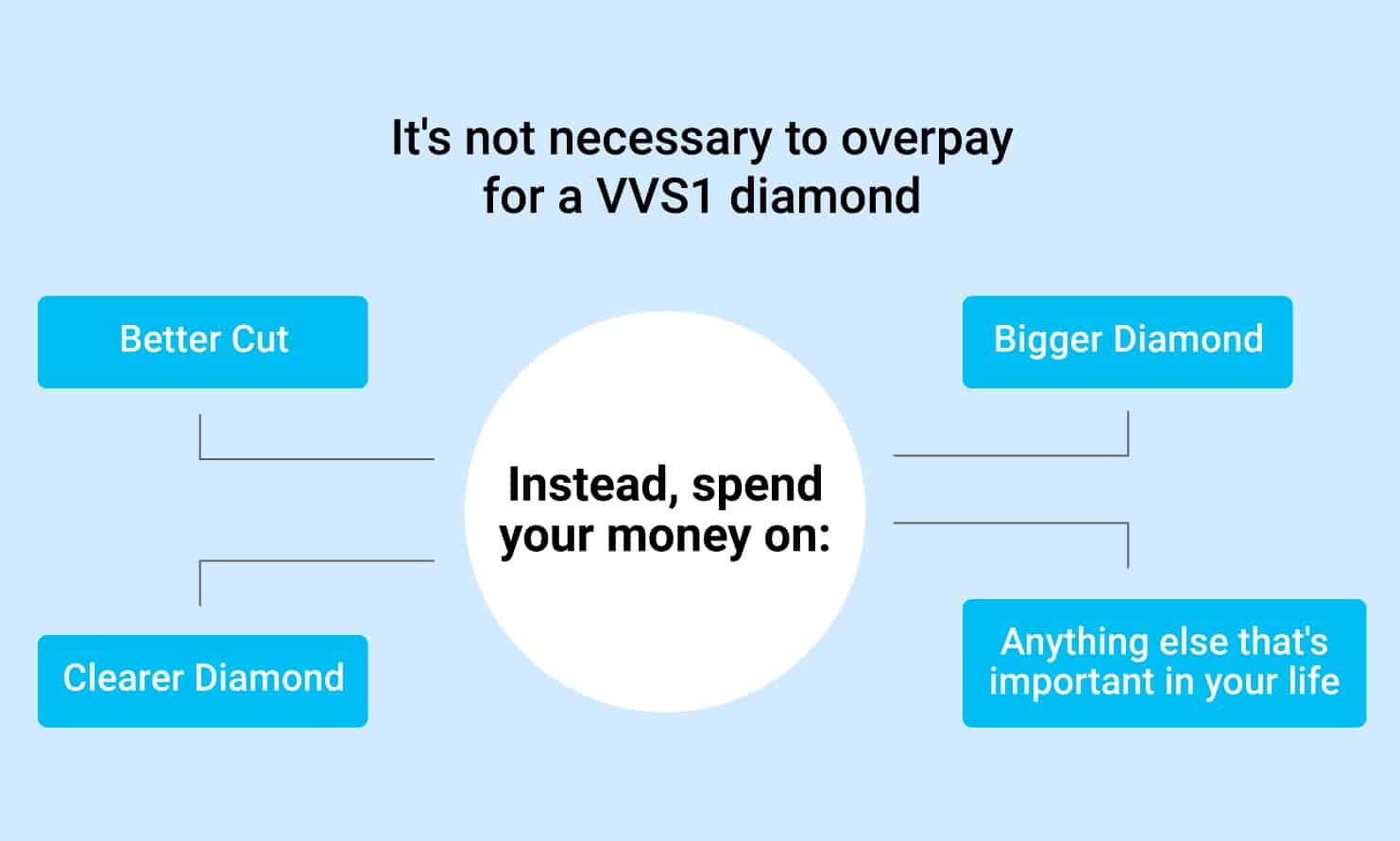Complete VVS1 Diamond Clarity Buying Guide
What is a VVS1 clarity graded diamond and should you buy one?
We are reader-supported. Buying through any red colored link on our site may earn us commissions. Learn More.
What is a VVS1 clarity graded diamond and should you buy one?
VVS1 clarity diamonds are diamonds with imperfections that are so small they’re difficult for an expert to see even under 10x magnification. Diamonds with a VVS1 grade are close to the top of the GIA clarity scale, falling just under the FL/IF grades. While this makes them visually stunning, it doesn’t necessarily make them the best choice for everyone. Lower grade diamonds like VS1, even down to an eye-clean SI diamond, can appear just as flawless to the naked eye but cost significantly less. Unless you’re a diamond connoisseur, choosing a VVS1 diamond might mean you’re paying more for a feature that won’t be noticeable. Are VVS1 clarity diamonds right for you? In this article, we cover everything you need to know about VVS1 diamonds to help answer that question.

VVS1 diamonds are absolutely stunning from a clarity perspective, but you are paying a premium for that. Take a look at this VVS1 diamond from Blue Nile and compare it to this VS1 diamond. Can you tell the difference between the two? If you can, is that difference worth almost $3,000 more? Those savings become more pronounced if you find VS2 or SI clarity grade diamond that is eye-clean.
Keep in mind that buying a diamond is a zero sum game. If you decide to pay for a VVS1 clarity grade, you may be sacrificing something far more important. Say you have to keep that same 2ct diamond under 20k. You can find one like this from Blue Nile, but this diamond has a far more fatal flaw (never buy a G/H color diamond with strong blue fluorescence).
Here’s what we’ll cover in this article:
What are VVS1 diamonds?
How much do VVS1 diamonds cost?
Where to buy VVS1 diamonds
Should I buy VVS1 diamonds?
FAQs
Why you should trust us
Clarity grades are determined by the GIA laboratory by “Evaluating diamond clarity involves determining the number, size, relief, nature, and position of these characteristics, as well as how these affect the overall appearance of the stone”.
A VVS1 diamond is a diamond with inclusions so tiny they can’t be seen even under 10x magnification (a standard jeweler’s loupe). That makes VVS1 diamonds eye-clean, so blemishes and inclusions can’t be seen by the naked eye. Only under a powerful microscope can trained professionals spot inclusions in VVS1s.
On the diamond clarity scale, VVS1 diamonds are a grade higher than VVS2 diamonds and a grade lower than internally flawless (IF) diamonds. VVS2 diamonds are more included than VVS1 diamonds and usually cost slightly less. Inclusions in VVS2s are barely visible under a standard jeweler’s loupe and are eye-clean.
When a lab professional determines clarity grade, they look at the location, size, number, and nature of the inclusions. For VVS1 diamonds, the inclusions are too small or too faint to be seen at 10x magnification. This VVS1 sample diamond from James Allen shows that VVS1 inclusions aren’t visible at this level of magnification.

While it may seem important to buy a diamond with such small or few blemishes, a VVS1 diamond isn’t the wisest choice. Here’s why: a VVS1 diamond is eye-clean, just like lower graded—and far less expensive—diamonds are. There’s no need to pay more for a characteristic that will go unnoticed.
We recommend steering away from VVS1 diamonds because you’re paying more than you need to. Depending on the diamond shape, we generally recommend looking VS1-SI1 clarity range. Just be sure that the diamond is eye-clean.
The VVS1 diamond price ranges from $1,100 for a well-cut 0.50 carat H color diamond like this one from Blue Nile to $21,640 for a 1.93 carat diamond and higher. Like any diamond, the price of a VVS diamond depends on the diamond cut, diamond color, shape and carat weight. The “VVS1” designation just refers to the clarity grade.
The average price of a round 1 carat VVS1 diamond with an H-I color is $5,500. For example, this 1 carat round cut with VVS1 clarity and H color from Blue Nile costs $5,730, while this 1 carat round VVS1 with I color is priced at $4,810. The average cost of a round 2 carat VVS1 round diamond with an H color is $23,000. As an example, this stunning 2 carat VVS1 diamond from James Allen is priced at $22,840.
VVS diamonds are more expensive than VS diamonds and significantly more expensive than SI diamonds. We don’t believe it’s worth buying a VVS1 diamond ring because the prices are significantly higher. They give you the same result as lower-graded diamonds: eye-clean diamonds.
You can learn more in our guide to diamond prices.
VVS1 diamonds are available at most jewelers, depending on inventory and the diamond shape you’re looking for. Reliable online vendors like Blue Nile and James Allen offer high-quality imagery of all diamonds so you can review them up close before purchase. James Allen and Blue Nile are more affordable because their overhead costs are low. They both carry a large selection of high-quality diamonds and engagement rings.

You can find VVS1 diamonds in all shapes and carat weights. Here are a few examples of VVS1 diamonds that are well-cut.
The most important aspect when considering diamond clarity is finding a diamond that’s eye-clean. While VVS1 diamonds are always eye-clean, you can find eye-clean stones in lower clarity grades for much lower prices. For instance, this VVS1 1.4 carat H color diamond from James Allen costs $10,290, while this VS1 1.4 carat H color costs $9.080. The VVS1 diamond costs $1,210 more than the VS1 diamond. Choosing the VS1 clarity gets you the same result as far as beauty, but costs a whole lot less. You’re better off putting your budget toward the most important diamond feature: cut quality. Cut dictates a diamond’s beauty and brilliance more than any other characteristic.

For diamonds under 2 carat, we generally recommend a clarity grade in the range of VS1-SI1 depending on the shape.
When it comes to 2 carat diamonds and greater, an SI1 or VS2 might not be eye-clean. Due to the size, it’s easier to see inclusions in the stone. Still, with these larger carat weights, you can typically find a VS1 – VVS2 diamond that’s eye clean, like this beautiful 3.59 carat VS1 from Blue Nile.
In most cases, it’s not worth paying extra for a VVS diamond, when you can get a diamond that appears identical with a lower clarity grade (and thus a lower price). The only time you want to consider buying VVS diamonds is for larger diamonds or certain shapes that show inclusions more clearly.
VVS1 diamonds are very rare, estimated to make up less than 1% of diamonds on the market. These diamonds are only slightly more common than the rarest of all diamond clarity grades, flawless diamonds.
VVS1 diamonds are expensive, compared to most other clarity grades. Be aware that you’ll pay a significant premium for a VVS1 diamond over a diamond graded in the VS1-SI1 range, yet it will not always provide any difference in quality when viewed by the naked eye.
A nice one carat round diamond that is VVS1 clarity costs about $6,000. The price can vary a bit based on which shape you select, what color grade you go with, and whether it’s well cut or not.
The most common mistake people make is purchasing a diamond with a clarity grade that’s too high to appreciate—thinking they’re getting a “good investment.” Diamonds are a retail product like any other, and—based on their resale value—shouldn’t be considered an investment.
That’s why it’s best to always look for a diamond with the lowest clarity grade that’s still clean to the naked eye. If you need help reviewing diamonds, contact us and we’ll provide you with a personal recommendation.




Before you buy a diamond, get personal buying advice from industry veterans. We'll help you get the best diamond for the money.
DISCLAIMER: We don't use your email for marketing. Period.
A diamonds’ price is determined primarily by the 4 Cs of the diamond. On the wholesale level, diamond prices are first based on a diamond shape and
Buying an engagement ring is often one of the first major purchases in a person's life. The process can be fraught with tension as there are so m
A wide range of 1 carat diamonds exist both in online markets and local diamond jewelry stores. Not only are there significant differences in beauty
Please enter your email address to receive your 25% off coupon code:
Here is your coupon code: GFDSF3GF